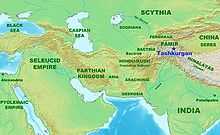Maes Titianus

Maës Titianus was an ancient traveller of Macedonian culture[1] who is recorded as having travelled farthest along the Silk Road from the Mediterranean world.[2] In the early 2nd century CE[3] or at the end of the 1st century BC,[4] during a lull in the intermittent Roman struggles with Parthia, his party reached the famous Stone Tower, Tashkurgan,[5] in the Pamirs.[6] Nothing is known of him, apart from a brief credit in Ptolemy's Geography, 1.11.7, whose knowledge of Maës was gained through an intermediary source, Marinus of Tyre:
"Marinus tells us that a certain Macedonian named Maen, who was also called Titian, son of a merchant father, and a merchant himself, noted the length of this journey [to the Stone Tower], although he did not come to Sera in person but sent other there"—Claudius Ptolemy, I-XI[7]
However, a brief article by Max Cary[8] teased apart some probabilities, notably that the purpose of the expedition was to organize the import of Chinese silk by controlling or eliminating some of the middlemen through whom trade goods were passed, among whom the least dependable were the Parthians. The Stone Tower was located in Xinjiang, the westernmost province over which the Chinese periodically attempted control. The incursion of the nomadic Kushan ca 50 AD blocked Chinese access to the West, but conditions improved ca 75; consequently the window in which, Cary suggests, Maës found his opportunity lay either before or after the Kushan irruption. At the western end of the trade route, Parthian cooperation could be expected only after the termination of their war with Trajan, 117 CE, too late for Marinus to incorporate the new information, at the close of their war with Nero, 65 CE, during the Kushan interruption, or, the date Cary offers for consideration, after their settlement with Augustus, 20 BCE.
The Maesii Titianii were a family documented in Italy and Sicily, ca 150-210, and Cary considers the possibility that the governor of Roman Syria from ca 13 BCE, M. Titius, who had been consul suffectus in 31 BCE, and through whose hands the Parthian princes passed to Rome for their education, acted in some way as a patron to the enterprise (Cary 1956:132-34).
See also
Notes
- ↑ He is described as a Macedonian by Ptolemy, but his "Macedonian" origin may betoken no more than his cultural affinity, and the name Maës is Semitic in origin (Cary 1956:130).
- ↑ In Antiquity, other unnamed Greeks may have gone further east before the formal establishment of the Silk Road: there are indications that from Alexandria Eschate the Greco-Bactrians may have led expeditions as far as Kashgar and Ürümqi in Xinjiang, leading to the first known contacts between China and the West around 220 BC. The Greek historian Strabo writes of the Greco-Bactrians that "they extended their empire even as far as the Seres (Chinese) and the Phryni" (Strabo, Strabo XI.XI.I). Also in India, the Indo-Greeks under Menander I led conquests as far as Pataliputra, probably the farthest known eastern foray of the ancient Greeks.
- ↑ The mainstream opinion, noted by Cary 1956:130 note 7, based on the date of Marinus, established by his use of many Trajanic foundation names but none identifiable with Hadrian.
- ↑ This is Cary's dating.
- ↑ Centuries later Tashkurgan ('Stone Tower') was the capital of the Pamir kingdom of Sarikol.
- ↑ J. Oliver Thomson located the Stone Tower in History of Ancient Geography (Cambridge University Press) 1948:179-80.
- ↑ Trans. Edward Luther Stevenson, ISBN 0-486-26896-9
- ↑ Cary, "Maes, Qui et Titianus" The Classical Quarterly, New Series, 6.3/4 (July–October 1956), pp. 130-134.
References
- Max Cary, "Maes, Qui et Titianus" The Classical Quarterly, New Series, 6.3/4 (July–October 1956), pp. 130–134.